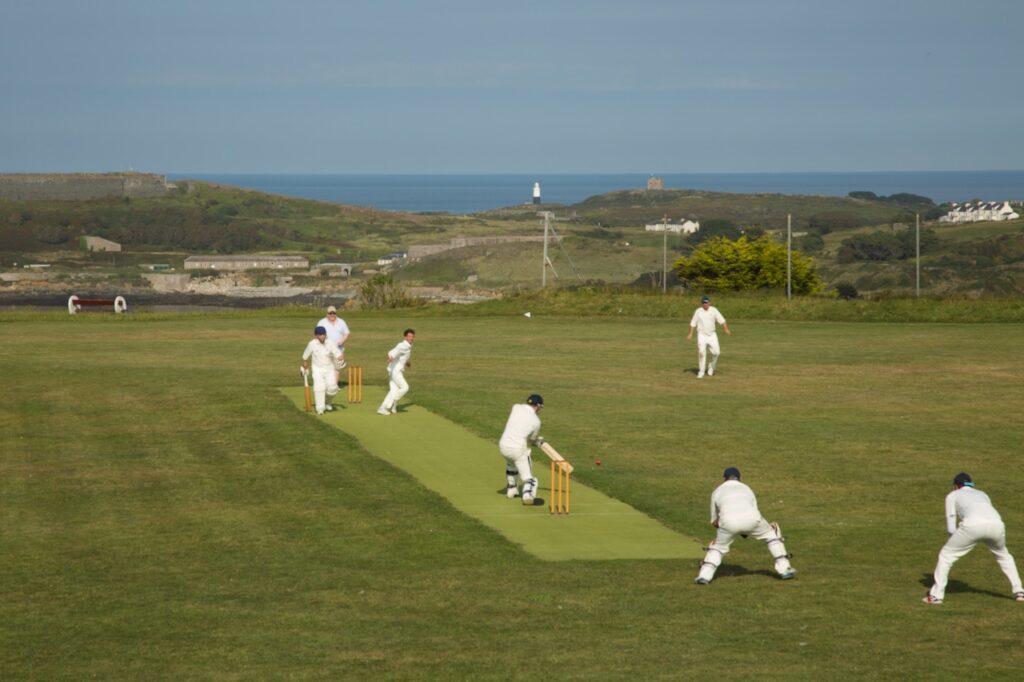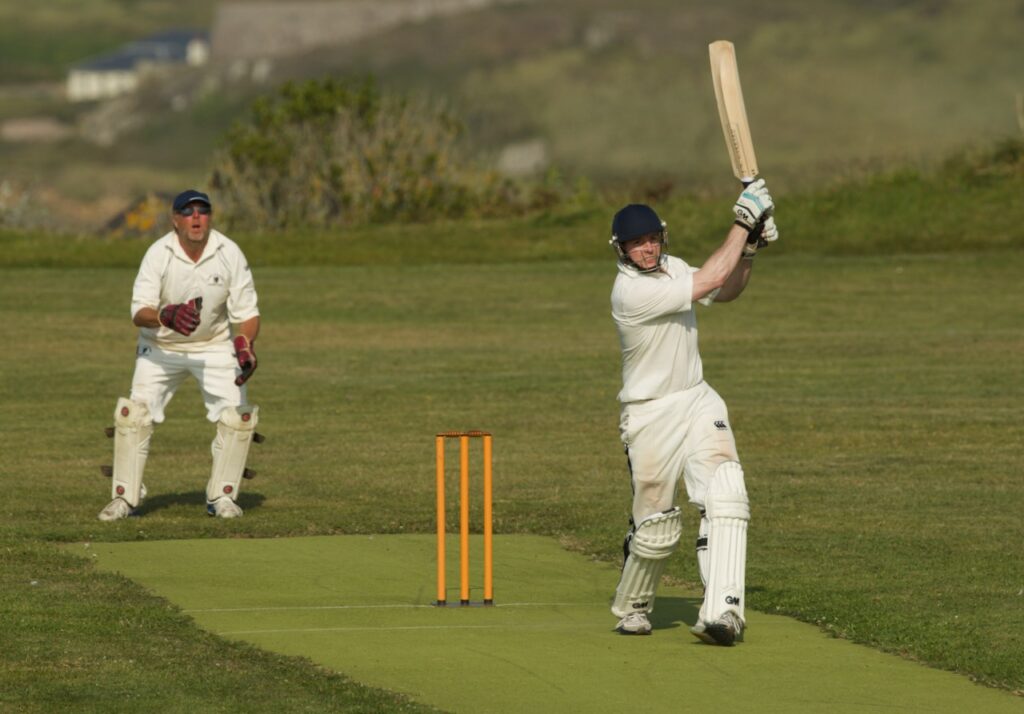Tour of Alderney, August 2021

Twenty-one Refreshers, WAGs and children flew out of Southampton on Thursday 26 August for our annual foreign CricketFest, this year to Alderney. A small island, just ten miles around, Alderney has a population of between 1500 and 2500 depending on who you listen to, many of whom are born and bred, and a few of whom remember the Nazi war-time occupation and the island’s evacuation in 1940. Amongst other notables who have called Alderney home in recent years are the late great John Arlott (whose wife has remained on the island) and the robust Ian (now Lord) Botham who has not, but has recently become both an Australian wine producer of note and at the same a UK trade ambassador, presumably to facilitate sales of his eponymously named wine into the UK.
The island itself is strikingly pretty, with beautiful long sandy beaches, rolling hills and a stunning coastline looking towards France (just 6 miles away) to the east, Guernsey to the south and a mass of hazardous rocks and small islands to the north and west. The current is strong and dangerous, and the water bracing but just about manageable from a swimming point of view (again, depending on who you ask – Cannon and Spurr were seldom out of the water, press-ganging Clapp to join them in leaping from the Douglas Pier into the water below on the Sunday morning). Everywhere you look are relics of Alderney’s past – Roman garrisons at the westernmost outcrop of their empire, elegant (ish) fortresses dating back to the Napoleonic wars, more fortresses built by Queen Victoria to protect her against any continuing unreliability on the part of the recently vanquished French armies – and most striking and least elegant of all, hundreds of Nazi fortifications of all shapes and sizes, built in grey concrete with slave labour (at great human cost) to defend the Channel Islands against the threat of re-invasion by the Allies after Hitler’s troops had themselves invaded in 1940.
An impressive colony of gannets have colonised a pair of islands just to the west, and we saw some other unique wildlife on the ‘mainland’ including the blond hedgehog, which has given its name to arguably the finest restaurant on Alderney.
Speaking of which, any Refreshers tour that Cayford and Cannon have ever organised is built around fine cuisine, and Alderney did not disappoint. Rather, we ate splendidly at some of the island’s 14 restaurants and bars, most notably at the said Blond Hedgehog, the Georgian House and the Vaults, as well as Le Pesked and the Marais Hall among others. Fish and crustaceans featured heavily of course, but the steaks were other-wordly in their flavour and there were also rave reviews for the snails at Le Pesked and the excellent breakfasts at our hotel, the Braye Beach Hotel, generally taken on the balcony overlooking the glorious sweep of sandy beach.
Turning briefly to the subject of cricket, the President found himself wondering during his end of tour ‘speech’ how it is that we have only won two games in the past 19 years of touring. He could answer his own question in part; the first was because, in 2011, 18 year old birthday boy Harry Wise took 5 for 20 against the Australian Bar in Bowral, from which they never recovered; and on the second occasion we had lent the oppo Keith Hornby who managed to play out five consecutive maidens in a 20/20 game.
Having analysed the potential reasons for our lamentable failure to win more than 2 out of more than 30 games on tour (late night drinking, four hour lunches, sleep deprivation, lack of enthusiasm, lack of skill, local advantage including bouncy wickets (Alderney), bouncy balls (Corfu), poor captaincy, women (a) players and (b) supporters, young children of differing skills and dependency) he concluded to general agreement that none of the above applied to the Refreshers and that our tour record must remain both a badge of honour and a carefully protected mystery.
The scorebook will tell you that in our first match, a T20, we batted first and scored 127, with Rowan Clapp making 63 of those. It also records that of the six wickets to fall, three went to run-outs, each of which could better be described as bunny suicides. Still, we had something on the board and if anyone within what we laughingly described as our ‘bowling squad’ could produce some magic there was always hope. The scorebook, however, recounts that one opener retired on 55 (nearly all in boundaries) at which time the other opener was 48 not out (ditto), with 11 overs left to bowl. There wasn’t much left for the other batsmen to do but they did it nonetheless, winning with nine overs to spare. It would be fair, for balance, to point out that Tom Dumont hit the biggest 6 of the afternoon, landing the ball over the car park on the longest side of the ground but also that the oppo’s innings lasted every bit as long as ours by reason of the fact that the ground, lovely though it might be, is perched on top of a large grassy hill – each one of their many sixes required mountain climbing expertise to retrieve the ball from the thick vegetation protecting the playing field from invasion.
Suitably chastened, but not for long, we swapped war stories with the oppo, who were charming and seemed genuinely pleased that we were visiting. The Georgian House was running a mobile kitchen in a large gypsy caravan on the ground – the lobster and prawn baps were little short of sublime.
Saturday was a well-earned rest day and different groups foraged outwards in different directions. Bicycles to rent (electric and otherwise), electric scooters, golf, historical tours of the island, wild swimming, bird watching, rock-pooling, sea-kayaking and wind surfing, and of course lunching were all on offer and taken up in the warm late summer sunshine.
Sunday was the big match day, 40 overs each, on the same ground. On a lovely sunny morning, we won the toss and chose to field, one of many decisions taken by the skipper on the basis that whatever we had done on Friday, we would do differently on Sunday. We vaguely hoped that this formula might extend to the result of the match itself, although there was little logic behind the premise. Clapp and Owen Darbishire opened the bowling to some effect, the former clean bowling their opener during his first over. He was replaced by a chap in a scruffy white T-shirt, who we thought would not last the over – he ended up being caught and bowled by Spurr for 127. We did take some wickets and some good catches (Willatt, Darbishire and Cayford) and Clapp was ably supported by Harry Spurr in particular in the bowling department. Hugh Willatt, on his 15th birthday, fielded with the enthusiasm of youth no longer available to some of the team, despite a full-face of the bat bazooka missing his head by millimetres.
So 281 to chase at 7 an over – not a problem. The pitch was true, if bouncy, and anything short could be comfortably heaved over the rope, as Rowan Clapp demonstrated in a classy innings of 51. Darbishire similarly adapted to local conditions, hitting four 6’s in his 27 not out, although that came after the Refreshers middle order had taken it in turns to get out, and the game was all but gone. Clapp and Darbishire apart, we did not really look like getting the runs and with ten overs to spare fell about 80 short.
Same result on and off the pitch as Friday, and with much fist bumping we agreed to return to Alderney on the first open date available during one of the forthcoming summers. We thanked our hosts, awarded caps to John Adamson (he of the scruffy t-shirt) and Jamie Sanderson (our host manager). They awarded caps to Rowan Clapp and Hugh Willatt (whose dad had managed to procure two enormous cakes to celebrate his 15thbirthday, and with which we felt obliged to assist). An excellent dinner in the Vaults, followed by a late night of merriment.
More free time on Monday. The Willatts played golf, Rowan Clapp ran around the island (again), Rachel had a net with Caroline Foster (nee Atkins) formerly an England international (2001-2011, 9 tests, 58 ODIs, 19 T20s), and the President read his new favourite cricket book, “It’s Always Summer Somewhere” by the founder and lead guitarist of the Maccabees, Felix White (now a cricket writer). All topped off by a splendid dinner at the Georgian House in their elegant and spacious upper-floor dining room; speeches from Paul Stewart (3) and a beautiful bouquet of flowers from Silvia for Vivienne Thomson to mark her appointment as “Mum of the Match”, one speech each from Cayford (see opening paras) and from Cannon (brief, but insightful). Rowan was our man of the tour, with Harry Spurr a worthy runner up. Tom Dumont won magic moment and Paul and Silvia won a prize for the most colourfully dressed tourists (by a long way). And so home. Lovely tour, lovely hosts, lovely tourists and inexplicably bad but enjoyable cricket. Hey ho, and hasta la vista!
PC
Team: Joe Cannon (Tour Manager and Captain), Philip Cayford (President), Rowan Clapp, Paul Stewart, Jon Willatt, Hugh Willatt, Owen Darbishire, Tom Dumont, Rachel Godschalk, Akhtar Ahmad, Harry Spurr.
And: Vivienne Thomson, Seoras Thomson Cannon, Evangeline Thomson Cannon, Judith Dumont, Tanya Andrews, Silvia Ziranek, Caroline Hartley, Jess Spurr, Al Spurr, Ted Spurr.

